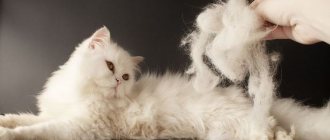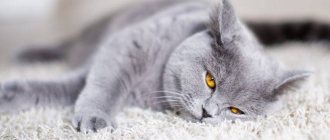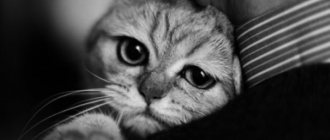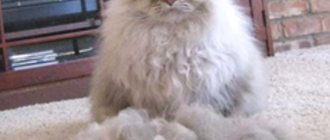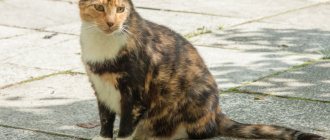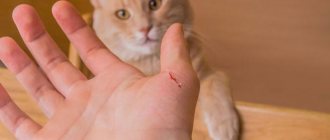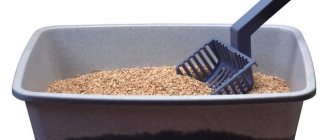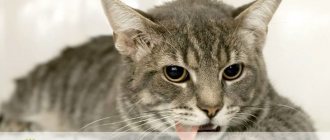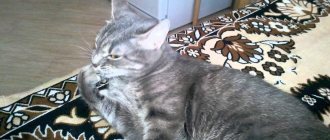When asked what disadvantages cats have as pets, many owners answer that they are tired of removing hair from carpets, furniture and clothes. Year-round intense shedding, during which the animal loses most of its coat, may be the result of improper living conditions or problems with the cat’s health.
Normal shedding in cats
Shedding is a natural process that helps an animal get rid of dead hairs and maintain a decent appearance. Even an indoor cat that doesn't go outside at all goes through this process. It is considered normal if there is a change of season or there are some characteristics of the breed. A cat after giving birth is quite susceptible to hair loss.
Seasonal hair loss is considered normal. Shedding usually occurs twice a year - in autumn and spring. It takes on average two weeks. The owners' task is to comb out the hair to prevent tangles from forming. This causes problems.
Typically, heavy shedding in cats is a breed characteristic and is not related to health problems or the season. Some breeds have longer, thicker hair, so they experience more hair loss. In heavily shedding breeds, the amount of hair shed is dictated by the quality and size of the undercoat. Among the breeds of increased shedding are: Somalis, British, Maine Coons, Toygers. They shed frequently, even every month.
Actions in case of pathological condition
First of all, pay attention to the well-being of the pet. If the cat feels normal, it is necessary to switch to super-premium hypoallergenic food.
The use of vitamin supplements along with natural food or economy-class food is dangerous.
An overdose will only increase shedding. If the cat feels unwell or changing food does not help, seek qualified help.
Be sure to read:
Bald patches in a cat near the ears and above the eyes: reasons, what to do, how to distinguish normality from pathology
Causes of increased shedding and its symptoms
Cats can have not only healthy shedding, but also pathological hair loss that is not associated with the breed or season. During prolonged and intense molting, the owner’s task is to take into account the condition of the animal:
- Stress causes hair loss in cats of any breed. Changing your usual diet, moving, adding a new person or animal to the family. It is important that the owner helps the cat adapt to such changes. In the most difficult situations, the veterinarian will prescribe a sedative.
- Improper nutrition - unbalanced or the same type - often leads to shedding in cats. The animal's menu should contain a sufficient amount of amino acids, vitamins, taurine, and proteins. If there is a deficiency of any of the listed substances, this leads to increased hair loss.
- Allergies in the form of dermatitis are a serious problem for purebred cats. If your pet sheds a lot, and you are sure that this is not caused by stress or dietary errors, then it may be allergic dermatitis. It may be associated with a change in food, the presence of certain indoor plants at home, a change in the usual tray filler, or the appearance of a new aroma. In this case, only eliminating the allergen and taking antihistamines as prescribed by a veterinarian can help.
- Skin diseases cause local or complete loss of hair. If any pathologies are detected after examining the pet, you must immediately show the pet to a veterinarian. In cats, the most common skin diseases are lichen, scabies, and hypothyroidism.
- Hormonal imbalances in cats occur during puberty, sexual activity, pregnancy, after birth and after sterilization. At the same time, the hormonal background changes, which causes changes in behavior, rapid weight loss, deterioration of immunity, and the fur comes out in clumps.
- Oncology and organ problems. Cancers affect systems and organs. The hair falls out uncontrollably, but there are no other external signs. Most often, cancerous tumors are associated with age-related changes, but they also occur in specific breeds. Problems with the kidneys, liver, gastrointestinal disorders - all this leads to shedding, negatively affecting the hair.
- Infection with helminths, ticks, and fleas leads to extensive hair loss and other consequences.
It is easy to detect a parasite infestation even at an early stage.
How to choose the right vitamins?
So, you noticed that your cat's hair is shedding a lot. What to do? If you are sure that the pussy is healthy and there is no reason to visit the veterinarian, you can simply buy a special vitamin complex. The choice will depend on several factors:
- age of the cat (vitamins are different for kittens and old cats);
- presence of pregnancy;
- preservation of the ability to reproduce (castrated and sterilized animals need a special complex);
- release form of the drug (gel, tablets, drops, paste);
- availability of a product certificate.
Flea dermatitis
This is the most common disease that is associated with allergic skin reactions to secretions secreted by fleas. Signs of the disease:
- The cat itches, licks itself, bites off fleas;
- The surfaces of the thighs and abdomen shed;
- There are bald patches with uneven borders that appear quickly and in large numbers;
- There are fleas on the animal's body or in the house.
You can diagnose an infestation by looking for fleas in the fur, but you can take your cat to the vet. The classic treatment option is treating the animal with flea substances and disinsection of the home. Furniture and cat litter require special attention.
How to treat hair loss?
If hair loss is associated with allergies, the following measures will help:
- identify the allergen, exclude salty and fatty foods from the diet;
- adhere to a special balanced diet recommended by your doctor;
- if you were given dry cat food, it is better to use a medicinal product for wool, recommended for animals prone to dermatitis;
- add special vitamins for wool to food;
- Give antiallergic drugs prescribed by your doctor.
If the dermatitis is of a flea nature, then first you need to get rid of the “neighbors”. Special preparations will help: shampoos, drops, collars or spray.
Self-treating shingles can be problematic. It is important to contact a competent specialist as quickly as possible. You will also have to:
- clean all carpets, bedspreads and furniture in the house with a disinfectant;
- wash and iron all clothes;
- disinfect the premises;
- Throw away, or better yet, burn all bedding, rugs and the animal’s house.
Heavy shedding: what to do?
Heavy shedding of a pet is not only a source of discomfort for the owner, but also a signal that there is a big threat to the pet’s health. Therefore, it is necessary to solve the problem yourself or under veterinary supervision.
Nutrition and vitamins
Each cat breed has certain body characteristics. Some breeds are more prone to allergies, some have more problems with the gastrointestinal tract or heart. The owner must study the characteristics of the breed in order to tailor their nutrition and individually select food and vitamins.
Dry food is considered the most convenient option, but some owners like to feed natural food for many reasons. In this case, together with the veterinarian, you can schedule the menu by week.
Room temperature
In some cases, it is sufficient to change the climate in the home. The animal should not come into frequent contact with radiators, and the air in the room should not be dry. For this, ordinary buckets of water or special humidifiers are used.
The balcony can be made a comfortable place for your pet so that it can restore the natural balance in the body.
Grooming
The cat needs regular brushing. This will reduce the amount of hair that falls on the floor and prevent the formation of tangles. An animal should be taught to groom itself from a very young age. Sometimes trouble can be solved by bathing. Naturally, this will not lead to a complete stop of hair loss, but special shampoos will help cope with skin problems. The new coat will gain shine and strength, and shedding will be less.
Veterinarian help
If there are certain signs of pathology, you need to show your pet to a specialist. The veterinary clinic will conduct examinations and tests to determine exactly what disease you are dealing with. The veterinarian will prescribe a treatment complex and monitor the animal’s health until it recovers completely.
Comfortable microclimate
If apartment owners love warmth, it is worth considering whether constantly high air temperatures are harmful to the health of their pets. Of course, there is no need to sacrifice your comfort and health and spend the winter wrapped in blankets. It is much more reasonable to use a system of compromises:
- ventilate the room more often;
- move the cat to the coolest room (rearrange its food bowls, toys and resting place there);
- turn on the air conditioning system in the apartment;
- If the air is too dry, turn on the humidifier.
Prevention of severe shedding
If increased shedding is noted, but skin diseases are excluded, it is necessary to comb the coat daily, helping the animal overcome this period more easily. It is recommended to walk your pet in the fresh air more often, and not to place a pet bed near heating devices. If the house is dry, it is recommended to humidify the air with a special device or other means. Proper coat care can be used to prevent severe shedding. It should be present not only during hair loss, but also during the absence of any problems.
High-quality care for long-haired cat breeds is provided through:
- Frequent and sparse combs;
- Furminator with long teeth;
- Soft rubber or lint brush;
- Metal brush;
- Special shampoo and conditioner.
To best remove loose undercoat, you need to use a furminator once a week. The rest of the time, the animal should be combed in the direction of hair growth with a brush or comb. Tangles must be removed in a timely manner.
Washing the animal is only necessary if the fur is actually dirty. Frequent bathing is bad for the condition of the cat's coat and leads to excessive nervous tension in the cat.
It is necessary to monitor the cat's nutrition, deworming and vaccination on time. If the animal walks outside a lot, it is necessary to select means to protect against parasites.
Popular cat vitamins for a healthy coat
There are a lot of preparations to improve the condition of the coat. It is best if they are selected and prescribed by a doctor. The most popular vitamins for cats against hair loss are:
- "Farmavit Neo";
- Cat Felltop Gel;
- "Vittri";
- Laveta Super For Cats;
- "Phytomins";
- Derm Liquid;
- "Sherstevit";
- Derm Caps;
- "Beafar";
- Gimpet Katzentabs;
- "Kitzim";
- Kitty's + Taurin + Biotin;
- Canina Cat-Fell OK;
- “8 in 1 Brewer’s Yeast Excel”;
- "Felvit."
Breeds with low shedding
There are cat breeds that are not characterized by active hair loss. These are mainly species that are bred artificially. Hairless breeds have almost no hair, so they have virtually no shedding:
- Sphynxes - some species are completely hairless, and some have hair up to 2 mm long;
- Rexes have short, wavy fur;
- La-perm - wool without undercoat, falls out completely during molting.
There are less exotic cat breeds that, under normal conditions, shed lightly. These are cats of the Siamese-Oriental group that do not have undercoat:
- The Abyssinian cat is short, smooth, and has thick fur;
- Siamese – the coat is shiny, short, and fits tightly to the body;
- Oriental – smooth-haired, has a shiny pile that fits tightly to the body.
All of these breeds shed less, but they are much more susceptible to dermatitis and various skin problems. They are not that easy to care for.
